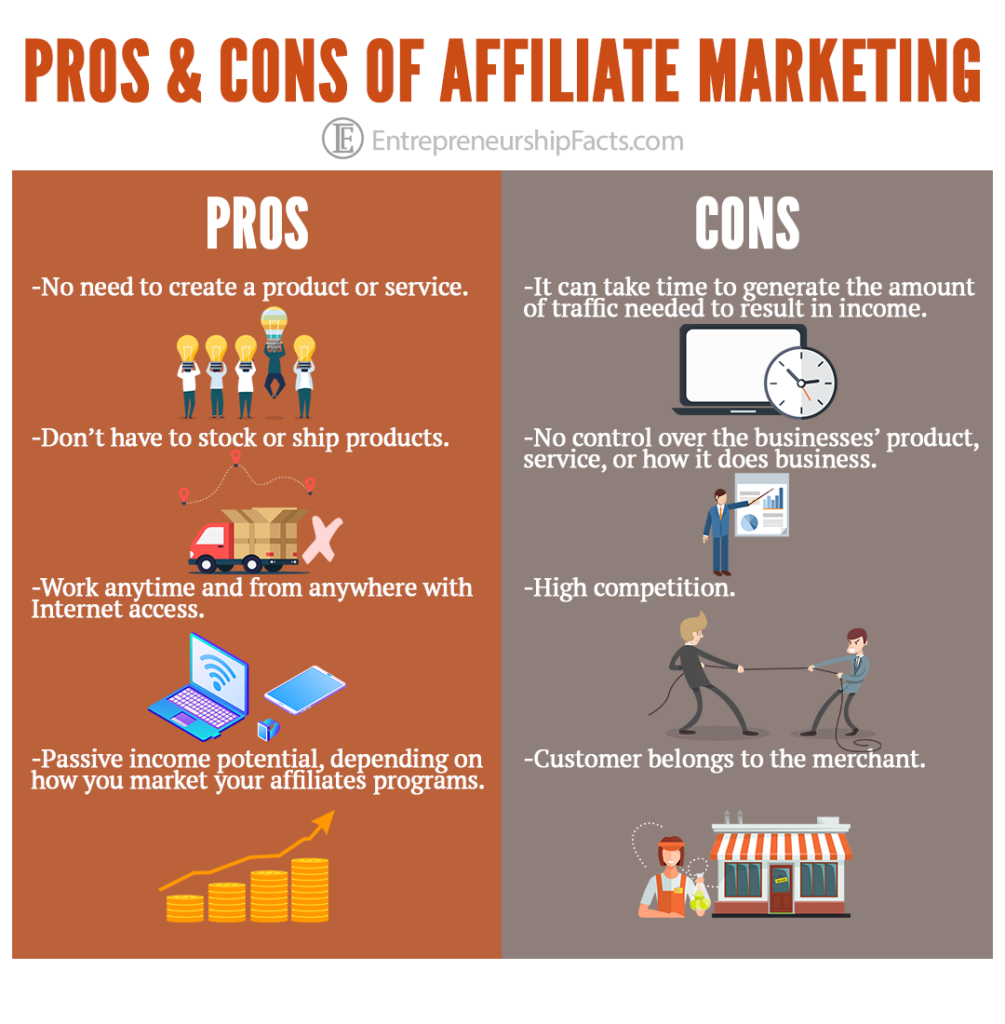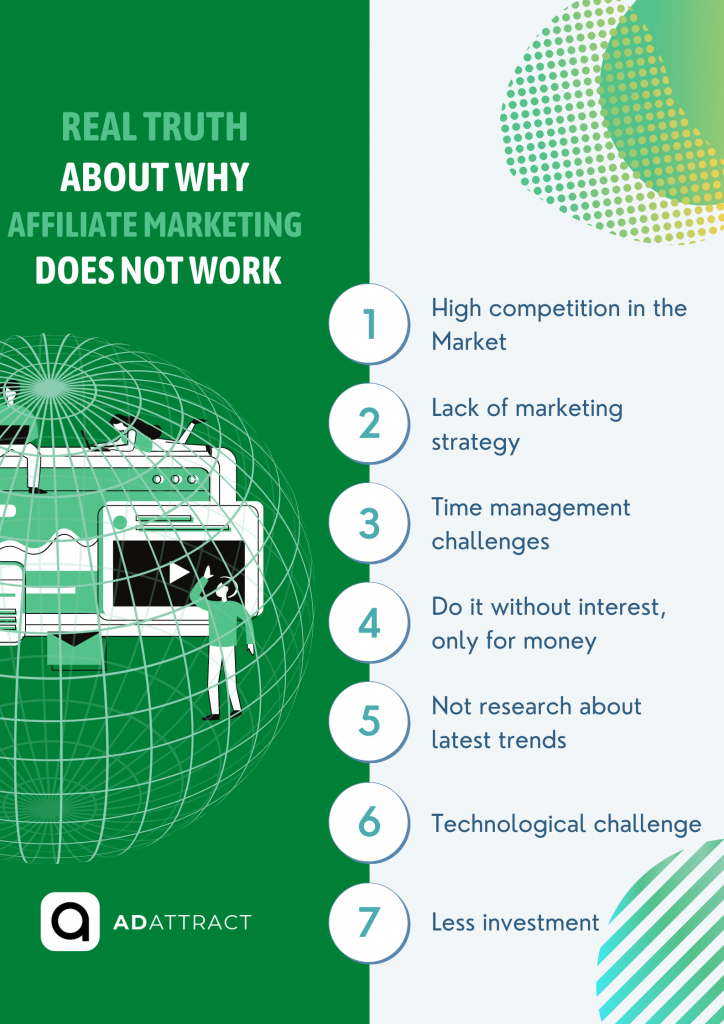So, you’re curious about affiliate marketing and wondering what the hardest part is? Well, it’s a great question! When it comes to affiliate marketing, the most challenging aspect is often finding the right products or services to promote. With countless options out there, it can be overwhelming to sift through them all and identify the ones that will resonate with your audience and generate significant sales.
Additionally, competition in the affiliate marketing space can be fierce. You not only need to find unique and valuable products, but you also need to stand out from other marketers who may be promoting similar offerings. Building a strong brand and establishing yourself as a trusted authority in your niche can make a world of difference in successfully navigating this competitive landscape. But remember, it’s not an insurmountable challenge! With dedication, research, and a bit of trial and error, you can overcome these hurdles and find success in affiliate marketing.
Choosing the Right Niche
Identifying profitable niches
Choosing the right niche is the foundation of a successful affiliate marketing business. To identify profitable niches, you should consider your interests, expertise, and market demand. Look for niches that have a decent number of potential customers and products or services that people are willing to spend money on. Conducting market research and analyzing trends can help you identify niches with growth potential and less competition.
Researching market demand
Before diving into a niche, it’s crucial to thoroughly research the market demand. Look for niches that have a large enough target audience to support your business. Conduct keyword research to understand the search volume and competition level for relevant keywords. Tools like Google Trends and keyword research tools can provide valuable insights into market demand and help you discover untapped niches.
Evaluating the competition
While competition is a sign of a thriving market, it’s essential to evaluate the competition before finalizing a niche. Identify who your competitors are, their strengths, weaknesses, and market positioning. By analyzing your competitors’ strategies, you can find gaps in the market that you can capitalize on. Keep in mind that entering a highly saturated market may require more effort and resources to stand out, so it’s important to weigh the competition before committing to a niche.
Building an Audience
Creating effective content
Creating effective content is crucial to building an audience in affiliate marketing. Content can take various forms, including blog posts, videos, podcasts, and social media posts. Focus on providing valuable and informative content that caters to your target audience’s needs and interests. Develop a content strategy that aligns with your niche and consistently produce high-quality content that engages and educates your audience.
Optimizing for search engines
Search engine optimization (SEO) plays a vital role in driving organic traffic to your affiliate marketing site. By optimizing your content and website for search engines, you can increase your visibility and attract targeted visitors. Conduct keyword research to identify relevant keywords and incorporate them strategically in your content and meta tags. Pay attention to on-page SEO elements such as meta descriptions, headings, and image alt tags to improve your website’s rankings in search engine results.
Engaging with social media
Social media platforms provide excellent opportunities to engage with your audience, build brand awareness, and drive traffic to your affiliate marketing site. Identify the social media platforms where your target audience is most active and create a presence there. Regularly share valuable content, interact with your audience, and participate in conversations related to your niche. Leverage social media advertising and influencer partnerships to expand your reach and drive more traffic to your website.
Building an email list
Building an email list is a crucial aspect of audience building in affiliate marketing. Email marketing allows you to establish a direct and personal connection with your audience. Offer valuable incentives, such as free ebooks or exclusive content, to entice visitors to subscribe to your email list. Nurture your subscribers by sending regular newsletters, updates, and promotional offers. Building and maintaining an engaged email list can significantly impact your affiliate marketing success.

Creating High-Quality Content
Researching and understanding the audience
To create high-quality content, it’s essential to research and understand your target audience. Gain insights into their demographics, interests, preferences, and pain points. Conduct surveys, interviews, or use analytics tools to gather data about your audience. This information will help you tailor your content to their needs and create content that resonates with them.
Generating unique and valuable ideas
Generating unique and valuable content ideas is key to setting yourself apart from the competition. Look for gaps in existing content and identify untapped areas within your niche. Conduct keyword research and analyze what content is performing well for your competitors. Use this information to come up with unique angles, insights, and perspectives that provide value to your audience.
Producing engaging and informative content
Once you have your ideas, it’s time to produce engaging and informative content. Use a mix of formats such as written articles, videos, infographics, and podcasts to cater to different audience preferences. Focus on delivering information in a clear, concise, and engaging manner. Use storytelling techniques, visuals, and examples to make your content relatable and memorable.
Maintaining consistency and quality
Consistency is crucial when it comes to content creation. Develop a content calendar and stick to a regular publishing schedule. This helps build trust and expectation with your audience. Additionally, ensure that your content maintains a high level of quality. Proofread, edit, and fact-check your content before publishing. Consistently providing high-quality content establishes you as an authority in your niche and keeps your audience coming back for more.
Driving Targeted Traffic
Implementing SEO strategies
Implementing effective SEO strategies is an integral part of driving targeted traffic to your affiliate marketing site. Focus on optimizing your website’s structure, content, and keywords to enhance its visibility in search engine results. Use relevant and targeted keywords in your content, meta descriptions, and headers. Build high-quality backlinks from authoritative websites to improve your website’s authority and organic ranking.
Utilizing paid advertising
Paid advertising can be a powerful tool to drive targeted traffic to your affiliate marketing site. Platforms like Google Ads, social media ads, and native advertising offer various targeting options to reach your ideal audience. Set clear goals, track your ad performance, and continually optimize your campaigns for better results. By investing in strategic paid advertising, you can reach a wider audience and increase your chances of conversions.
Leveraging social media platforms
Social media platforms are more than just engagement tools; they can be powerful traffic generators for your affiliate marketing site. Build a strong presence on the platforms where your target audience is active and share valuable content regularly. Encourage followers to visit your website by providing clear calls-to-action and incentives. Engage with your social media community, host live events, and collaborate with influencers to expand your reach and drive traffic.
Engaging in influencer marketing
Influencer marketing is a popular strategy that can drive targeted traffic to your website. Identify influencers within your niche who have a significant following and align with your brand values. Collaborate with these influencers to showcase your affiliate products or services. This partnership can help you tap into their followers’ trust and credibility, resulting in increased website traffic and conversions.
Exploring email marketing campaigns
Email marketing can be a highly effective strategy for driving targeted traffic. Use your email list to deliver valuable content and exclusive offers to your subscribers. Segment your email list based on interests and preferences to ensure you send relevant content. Include clear calls-to-action in your emails that drive recipients to visit your website. Regularly analyze and optimize your email campaigns to increase engagement and click-through rates.

Converting Visitors into Customers
Designing compelling landing pages
A compelling landing page is essential for converting visitors into customers. Design your landing page with a clear and attention-grabbing headline that highlights the benefits of your affiliate product or service. Use persuasive copy, visuals, and testimonials to build trust and credibility. Include a prominent call-to-action button that leads visitors to take the desired action, whether it’s making a purchase or signing up for a free trial.
Crafting persuasive call-to-actions
Crafting persuasive call-to-actions (CTAs) is crucial to guide visitors towards conversion. Use action-oriented language and compelling visuals to encourage visitors to take the desired action. Place CTAs strategically throughout your content and website, ensuring they are visible and easy to click. A well-crafted CTA can significantly impact your conversion rates and help you achieve your affiliate marketing goals.
Implementing effective sales funnels
A well-designed sales funnel is key to converting visitors into customers. Map out the customer journey and create a series of targeted touchpoints that guide them towards conversion. Offer valuable content, lead magnets, or discounts to capture their contact information. Nurture leads with personalized email campaigns, retargeting ads, and follow-ups to build trust and incentivize conversions.
Optimizing website performance and user experience
Website performance and user experience play a crucial role in converting visitors into customers. Ensure that your website is fast, mobile-friendly, and optimized for different devices and browsers. Make navigation intuitive and seamless, enabling visitors to find the information they need quickly. Test your website’s performance regularly and optimize it for speed, usability, and conversion potential.
Managing Affiliate Partnerships
Finding reputable and relevant affiliate programs
When managing affiliate partnerships, it’s important to find reputable and relevant affiliate programs. Research and identify affiliate programs that align with your niche, products, or services. Read reviews, check for transparent commission structures, and ensure that the affiliate program has a good reputation in the industry. Choose programs that offer products or services that provide value to your audience.
Negotiating commission rates and terms
Negotiating commission rates and terms is an important aspect of managing affiliate partnerships. Assess the value you bring to the affiliate program and negotiate fair and competitive commission rates. Take into consideration factors such as the demand for the product, your audience size, and the promotional efforts you’ll be putting in. Clearly define the terms and conditions of the partnership to avoid any misunderstandings later on.
Monitoring and analyzing affiliate performance
To effectively manage affiliate partnerships, it’s crucial to monitor and analyze the performance of your affiliate campaigns. Track the performance of each affiliate link or promotion to understand which ones are generating the most clicks and conversions. Use affiliate tracking software or platforms to evaluate the success of your partnerships and optimize your strategies accordingly.
Maintaining relationships with affiliate partners
Maintaining strong relationships with your affiliate partners is key to long-term success. Communicate regularly with your partners, providing updates and insights on your progress. Offer support and assistance whenever needed, and be proactive in addressing any concerns or issues. Building strong relationships with your affiliate partners can lead to increased collaboration, trust, and ultimately, higher conversions.

Tracking and Analyzing Performance
Implementing tracking mechanisms
To track and analyze performance effectively, it’s important to implement tracking mechanisms. Use tools such as Google Analytics or affiliate tracking software to measure and track key metrics. Set up conversion tracking to understand which marketing channels and strategies are driving the most conversions. Monitor traffic sources, bounce rates, click-through rates, and conversion rates to identify areas for improvement.
Analyzing conversion rates and key metrics
Analyzing conversion rates and key metrics is essential to understand the effectiveness of your affiliate marketing efforts. Calculate conversion rates for different marketing channels, campaigns, and landing pages to identify top performers. Dive deeper into the data to understand the factors driving conversions or hindering them. Analyze metrics such as average order value, customer lifetime value, and return on investment to gain insights into the profitability of your affiliate marketing campaigns.
Identifying areas for improvement and optimization
Regularly reviewing your tracking and performance analysis allows you to identify areas for improvement and optimization. Look for patterns and trends in the data to understand what strategies are working and what areas need improvement. Optimize poorly performing campaigns or landing pages by making adjustments to your content, design, or targeting. Continually test and experiment with different strategies to optimize your affiliate marketing performance.
Staying Updated with Industry Trends
Continuous learning and adaptation
In affiliate marketing, staying updated with industry trends is crucial to stay ahead of the competition. Engage in continuous learning by reading industry blogs, attending conferences, and participating in online forums or webinars. Stay informed about new tools, technologies, and strategies that can enhance your affiliate marketing efforts. Adaptation is key; be willing to experiment, test new approaches, and pivot your strategies when necessary.
Following industry influencers and resources
Following industry influencers and resources is a great way to stay updated with the latest trends and insights. Identify thought leaders in your niche and follow them on social media, subscribe to their newsletters, and read their blogs. Listen to podcasts or watch webinars hosted by experts in the field. These influencers and resources can provide valuable information and inspiration for your own affiliate marketing strategies.
Keeping up with algorithm changes and updates
Keeping up with algorithm changes and updates from search engines and social media platforms is crucial to maintaining your website’s visibility and reach. Stay informed about any updates or changes in algorithms that may affect your SEO and social media strategies. Regularly review and optimize your content and website to align with the latest best practices and ensure compliance with platform policies.
Identifying and adopting new strategies and techniques
The affiliate marketing landscape is ever-evolving, and it’s important to identify and adopt new strategies and techniques. Stay open to experimentation and be willing to try new approaches to see what works best for your niche and audience. Keep an eye on emerging trends such as influencer marketing, video content, or voice search optimization. By adopting new strategies and techniques, you can stay ahead of the curve and maintain a competitive edge.

Managing Time and Priorities
Balancing different tasks and responsibilities
Effective time management and prioritization are crucial when managing an affiliate marketing business. Balancing various tasks and responsibilities requires setting clear goals and deadlines. Create a schedule or calendar that outlines your daily, weekly, and monthly tasks, ensuring a balance between content creation, marketing efforts, and administrative tasks. Prioritize tasks based on their importance and urgency to optimize your productivity and time.
Effective time management and organization
To effectively manage your time, it’s important to develop effective time management and organizational skills. Utilize tools and apps that can help you streamline your workflow and stay organized. Set specific time blocks for different tasks and avoid multitasking as it can reduce productivity. Prioritize deep work, where you can focus and immerse yourself in important tasks without distractions.
Prioritizing high-value activities
Not all tasks contribute equally to your affiliate marketing success. Prioritize high-value activities that directly impact your business goals. Identify which tasks generate the most significant results and focus your time and energy on those. Delegate or automate tasks that can be outsourced, allowing you to focus on activities that require your expertise and attention.
Avoiding overwhelm and burnout
The demands of running an affiliate marketing business can sometimes be overwhelming. It’s important to prioritize self-care and avoid burnout. Set boundaries between work and personal life and establish a healthy work-life balance. Take breaks, exercise regularly, and engage in activities that recharge you. Seek support from peers or mentors who understand the challenges of affiliate marketing and can provide guidance and encouragement.
Overcoming Self-Doubt and Rejection
Dealing with rejection and setbacks
In affiliate marketing, rejection and setbacks are inevitable. It’s important to develop resilience and learn how to deal with rejection. Understand that not every promotion or partnership will be successful, and it’s part of the learning process. Use rejection as an opportunity to analyze and improve your strategies. Cultivate a growth mindset and view setbacks as learning experiences that can strengthen your skills and abilities.
Building confidence and resilience
Building confidence and resilience is essential to overcoming self-doubt and achieving success in affiliate marketing. Focus on your strengths and achievements, and celebrate small wins along the way. Surround yourself with supportive and positive individuals who can provide encouragement and perspective. Invest in personal development and continually work on improving your skills and knowledge in your niche.
Maintaining motivation and persistence
Maintaining motivation and persistence is crucial in the face of challenges and setbacks. Set clear goals and remind yourself of your why – the reasons that drove you to pursue affiliate marketing in the first place. Break down your goals into manageable steps and celebrate each milestone. Find motivation through engaging with your audience, receiving positive feedback, or seeing the impact of your efforts.
Seeking support and guidance
When self-doubt arises, seeking support and guidance can be tremendously helpful. Connect with other affiliate marketers through online communities or forums to share experiences and learn from each other. Reach out to mentors or industry experts who can provide guidance and advice. Having a support system can provide reassurance and motivation during challenging times.
In conclusion, affiliate marketing can be a rewarding and profitable venture, but it requires careful planning, strategy, and continuous improvement. By choosing the right niche, building an audience, creating high-quality content, driving targeted traffic, converting visitors into customers, managing affiliate partnerships, tracking and analyzing performance, staying updated with industry trends, managing time and priorities, and overcoming self-doubt and rejection, you can position yourself for success in the ever-growing world of affiliate marketing.
